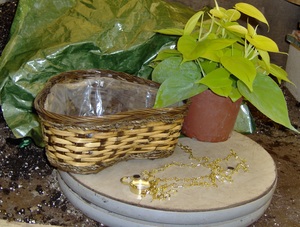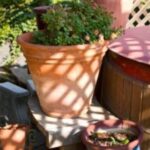I began in Horticulture in 1972 when indoor plants were “in” style. The market for interior growing was big throughout the word. It was easy to find items for your interior growing just about anywhere. The baby boomer generation took green inside and it was the beginning of a huge market. Potters concentrated on making hanging planters in various sizes and styles, and prices were competitive. Now, finding a really nice inexpensive ceramic hanging pot is next to impossible. I still have some of the pots I purchased from local potters who were just starting out in their profession. These I cherish because they are one of a kind and irreplaceable.
Today, these older professional potters are in the dish business and it is next to impossible to fine one of the old crew to make some inexpensive pots for hanging. Of course, the cost of firing has increased 10 fold from the “old days”, and they need to produce for a market that is willing to pay the prices for what is popular these days.
Unfortunately, I still have the need for really nice pots in which to display my hanging plants. Those plastic hanging pots that plants come in now are an eyesore to any interior. The simple act of changing the pot makes all the difference, and changes the appearance of the plant a thousand fold. The solution for me was simple. I make my own hanging pots from any ceramic pot or basket that fits my needs. The process is very easy and I use only a few basic tools to convert almost any ceramic, clay, or basket in to a one-of-a-kind planter that not only sets off my plants, but also complements my décor.
In this article, I will show how easy it is to convert any basket to a hanging container without using those old fashion macramé hangers. They are expensive and difficult to place a plant into and take out of without destroying half the foliage. The pictures show how I changed one rather odd-shaped basket in to a unique hanging specimen with only a chain kit, (includes four hooks and lengths of chain), some poly foil, small stones, horticulture charcoal, two pliers, and a plant.
This basket is rather unique in that it has three sides for three six inch potted plants. Picture one shows the ingredients needed to convert the tabletop basket into a rather neat looking hanging pot. The polyfoil is a floral foil with plastic in between two pieces of foil. You can usually get it at a local florist or craft store. This basket has three equidistant sections where the basket curves to the inside. These are the points where I insert the three small hooks from the chain kit in to the sides of the basket.
The first step is to line the basket with the polyfoil making sure to fold the foil to the sides of the inside the top of the basket so water will not get in between the liner and wicker, which will rot quickly when coming in to contact with water. Picture two shows the end result of pressing the polyfoil neatly into the basket. Even if the basket has a liner, especially a flexible plastic liner sewed to the inside, I highly recommend replacing it with the polyfoil. It is very strong and resists tearing, which is very important in protecting the wicker from the water and rotting.
After the polyfoil covers the inside of the basket, it is time to add the hooks to the basket sides. Since wicker is made from rows of inter-weaved dried foliages, it is not very strong and the rows can separate if the weight is too great. To avoid separating, I make sure the hooks are about 1//2 inch below the top rim. It is very important to make sure each hook is in the exact same distance from the top of the rim or the planter will hang crooked. I use a ruler to measure the distance and mark it with a pencil so the mark is not visible.. The hooks then go between the rows and I use duct tape or floral clay in the inside behind the foil to help keep the integrity of the basket shape. I then clamp the bottom of the hoods together so they will not come out of the basket. I then attach the chain lengths to the top of the hooks and clamp them together using two sets of pliers. This insures that the chain will not fall out of the hooks.
The next step is to cover the bottom of the basket with 1/2 inch of small stones and then a single layer of horticultural charcoal. The reason for his is because the basket does not drain and a there needs to be a water reservoir to help minimize the roots from sitting in water. The charcoal is a purifier that breaks up bacterial and fungal colonies as the water passes through it after watering and as the plant takes up water as the soil surface dries. The polyfoil is strong and the stones will not puncture it and cause leaks.
Once the interior is set, it is time to put the plant into the planter using a tropical blend potting mix that is sterile and non-clumping. Then water the plant until the soil is dark and evenly moistened. Because there is no drainage, the top of the soil should dry down ½ inch before watering the plant again. Then water only the ½ inch that is dry. (See the article Planting in non-draining containers.)
Now, you have a one-of-a-kind, handcrafted hanging planter that is unique and will compliment any interior space. Using this method, you can make any number of hanging planters for all your plants and make your interior spaces a growing garden of green and color.
I like the effects of a bowl-shaped wicker basket because it looks especially nice hanging with a healthy plant growing out along the rim. But any shape will do. It is very important to use the correct size basket for the plant you put in to it. If the root system fills ½ of the interior of the pot, then the plant will flourished with the proper water and light. If you use a basket that is too big thinking, as many do, that the plant will grow in to the pot, the plant is in grave danger of being over or under watered leading to plant death.
In the same way, I drill holes in ceramic and clay pots to turn them in to hanging planters. The method is the same, but making sure the holes are equidistant around the circumference is a bit trickier. I still use a ruler to measure the distance from the top of the rim to make sure the planter hangs straight. If there is a hole in the bottom of the pot, I usually block it by gluing a rim of hot glue around the hole on the inside and pressing a piece of crockery in to it to make a watertight bond. You can use a bead of Elmer’s glue or other craft glue and let the crockery sit over night until it is dry before planting. By doing this, you will prevent any water draining out the bottom on to anything that may be beneath it. I usually cover the holes in the side of the pot where the hooks go through with a clump of floral clay to make the holes water tight as well.
If anyone is interested in viewing other planters I made using the above method, you can see them at www.nature-in-designs.com.






